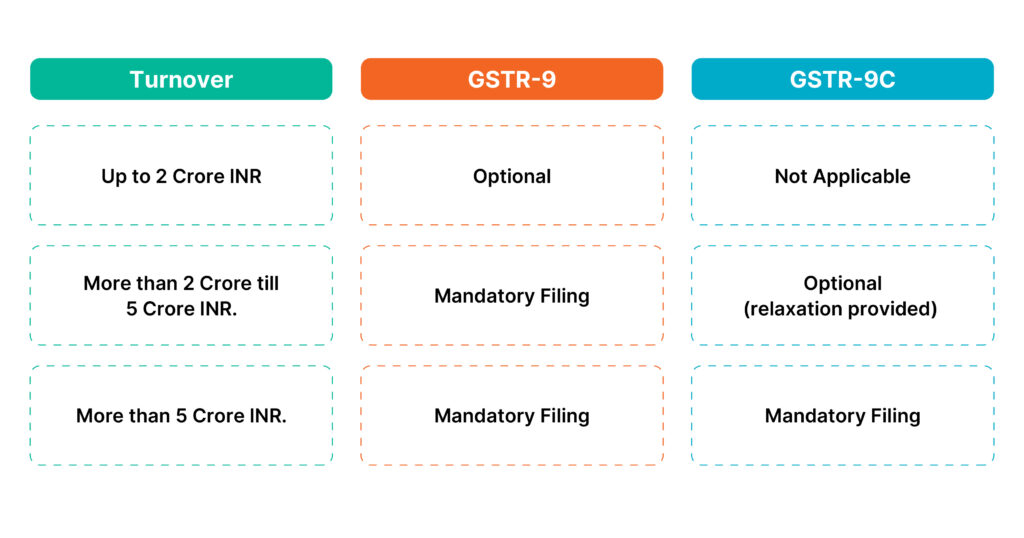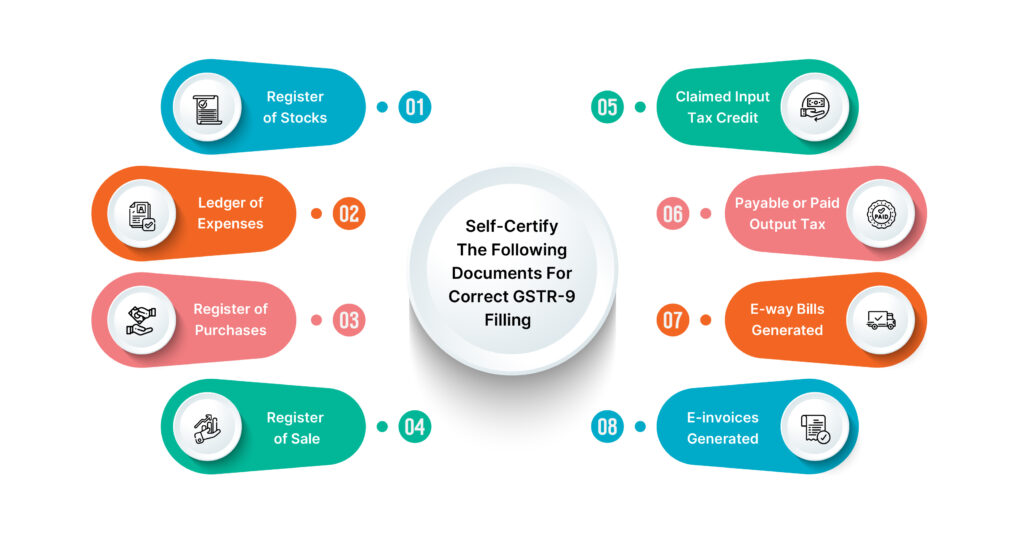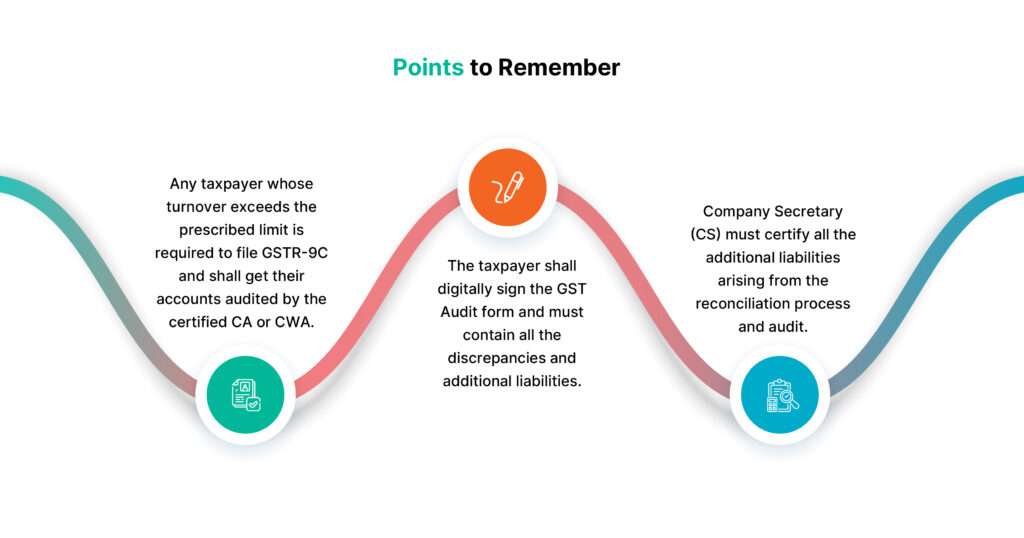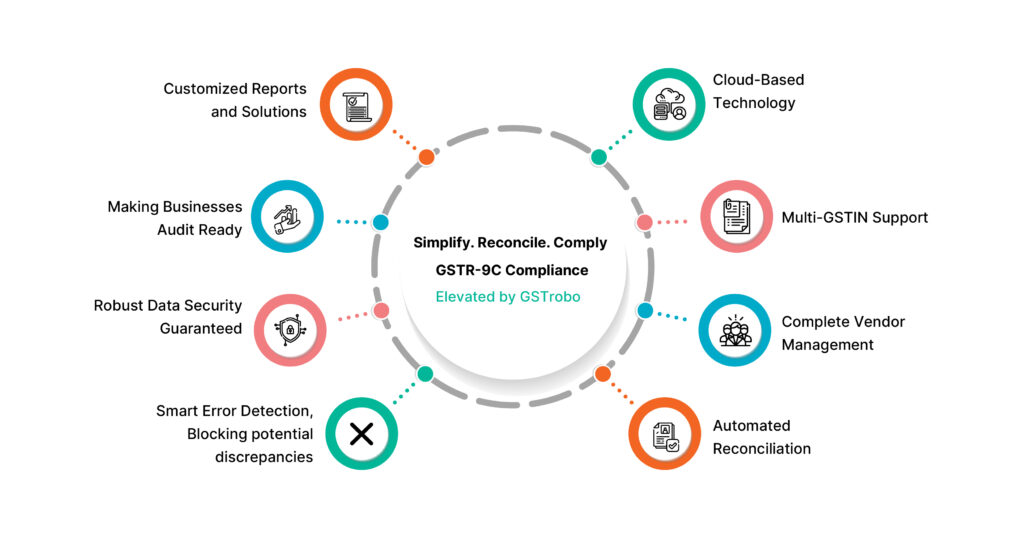GSTR-9C: A Comprehensive Overview
What is GSTR-9C?
On 13th September 2018, GSTR-9C was introduced in GST Law. Under GST, GSTR 9C is an annual audit form that the applicable taxpayers shall furnish. In addition to this GST Audit form, the taxpayer must file the GST reconciliation statement and the audited copies of the annual financial statements as specified under sub-section (5) of section 35 of the CGST Act.
It shall be noted that the annual return reconciliation statement of the taxpayer can be audited by the certified Chartered Accountant (CA) or Cost and Work Accountant (CWA). Still, it is no longer a compulsory requirement, but self-certifying your GSTR-9C statement is compulsory.
GSTR-9C Applicability – Who Should File GSTR-9C
Every taxpayer registered under GST with an annual aggregate turnover of 5 Crore INR or more during a financial year must furnish details of the annual return reconciliation statement in the GSTR-9C return file as they are under the provisions of GSTR-9C applicability.

GSTR-9C Amendments and Updates
Here are the significant amendments and updates in GSTR-9C:
- Taxpayers can now self-certify the GSTR-9C reconciliation statement, and CA/CMA certification is no longer compulsory.
- You can now disclose the Unbilled Revenue for the beginning of the year in Table 5B.
- Other Turnover reconciliation items from table 5C to 5N are now reported separately.
- It is mandatory to disclose Tables 12B and 12C separately.
- There is the inclusion of a new 6% tax rate.
- DRC-03 payments for reconciliation statement differences are now made through the electronic cash ledger.
- Tables 12B, 12C, and 14 (ITC reconciliation) are now not mandatory.
- A few changes have also been made in the Declaration part.
GSTR-9C Exemptions
Certain taxpayers and businesses fall under the GSTR-9C Exemptions:
- Companies that are in the airline business and are compliant with the relevant provisions and rules of the Companies Act 2013.
- Non-residents providing OIDAR service in India to unregistered persons.
FOR MORE INFORMATION — GSTR-9 Annual return filling
What are the consequences of not filling GSTR 9C on Time (GST Audit Form)?
In case a taxpayer fails to file the GST Audit form within the due date, then in such a case that taxable person needs to pay 200 INR per day as a penalty, which includes 100 INR CGST and 100 INR SGST/UTGST. However, this penalty amount cannot surpass the limit of 0.50% of the total aggregate turnover as per GST compliance rules.
What are the different ways to file the GST Audit Form (GSTR 9C) or How to file GSTR 9C in India?
There are 2 ways using which a taxpayer can furnish a GST Audit form and they are:
(i) Online; and,
(ii) Offline utility

GSTR-9C Details, Filling Format and Instructions
The financial figures in the audited financial statements are consolidated at the PAN level. Consequently, the turnover, tax payments, and Input Tax Credit (ITC) earned for a specific GSTIN (or State/UT) need to be extracted from the comprehensive audited accounts of the entire organization.
The Reconciliation Statement is structured into five parts:
Part I: Basic Details
This section includes fiscal year details, GSTIN, Legal Name, Trade Name, and information about any audits under other laws.
Part II: Reconciliation of Turnover
Here, the task involves aligning the turnover figures declared in the Annual Audited Financial Statements with those in the Annual Return (GSTR-9). Given that Audited Financial Statements typically operate at a PAN level, a breakdown at the GSTIN level may be necessary for reporting the reconciliation of sales figures in GSTR 9C. While adjustments in tables 5B to 5N are optional, any necessary adjustments can be reported in Table 5O by the taxpayer, in accordance with Notification No: 56/2019 issued on 14th November 2019.
Part III: Reconciliation of Tax Paid
This part entails a GST rate-wise breakdown of the tax liability from the accounts and that paid as reported in GSTR-9, highlighting any differences. Additionally, taxpayers must declare any additional liability resulting from unreconciled differences identified during the reconciliation process.
Part-IV: Reconciliation of Input Tax Credit (ITC)
In this segment, reconciliation is performed on the input tax credit availed and utilized, as reported in GSTR-9 and the Audited Financial Statements. It also necessitates reporting expenses booked per the GST Return and Audited Accounts, distinguishing between eligible and ineligible ITC. The reconciliation of eligible ITC with the amount claimed in GSTR-9 is then declared, accounting for any reversals of claimed ITC. Taxpayers can choose not to fill in details of ITC reconciliation in tables 12B, 12C, and 14, following Notification No: 56/2019 issued on 14th November 2019.
Verification/Self-Certification by Taxpayer
This final step involves the taxpayer’s self-certification or verification of the provided information in the GST Reconciliation Statement.

How GSTrobo Streamlines and Makes GSTR-9C Easy?
GSTR-9C filling is a challenging task while managing GST Compliance. With multiple returns to evaluate, reconciliation of e-invoices with your returns filed, getting the proper documents from your suppliers and putting everything together on time, GSTR-9C takes effort, time and precision. Achieving the same can be daunting. At this point, leveraging the benefits of GST Software can come in handy. With automation and cloud-based technology, GST Software makes your GSTR-9C easy, quick and accurate.
GSTrobo is one such software technology that has the power to revolutionize your GSTR-9C filling process by introducing a seamless and user-friendly approach, making GST compliance effortless for businesses. Here’s how GSTrobo streamlines and simplifies GSTR-9C:
GSTrobo revolutionizes the GSTR-9C filling process by introducing a seamless and user-friendly approach, making GST compliance effortless for businesses. Here’s how GSTrobo streamlines and simplifies GSTR-9C:

1. Automated Data Extraction
– GSTrobo automates the extraction of relevant data from various sources, eliminating the need for manual data entry and reducing the risk of errors.
2. Integration with Financial Systems & ERPs
– GSTrobo software seamlessly integrates with financial systems & ERPs, ensuring that data from audited financial statements is accurately reflected in the GSTR-9C filling.
3. Real-time Reconciliation
– With GSTrobo, businesses can enjoy real-time reconciliation between their GST return audited accounts and audited financial statements and GST returns, providing instant insights into any discrepancies.
4. User-Friendly Interface
– The user-friendly interface of GSTrobo ensures that even finance teams with limited tax expertise can navigate the GSTR-9C filling process effortlessly, saving time and resources.
5. Notification Compliance
– GSTrobo keeps users informed about relevant notifications and updates, whether regarding GST law or your vendors, ensuring that the filling process aligns with the latest regulatory requirements and changes.
6. Detailed Reporting
– The software generates detailed reports required for GSTR-9C filling, offering a comprehensive overview of turnover, tax paid, and Input Tax Credit (ITC) reconciliation.
The Bottom Line
At last, we can conclude that the GST audit form or GSTR-9C is the only measuring yardstick that helps the GST authorities to verify the authenticity of GST Return and Audited Accounts filed by the taxpayer during a particular financial year.
FAQs
Q1. What items are included at the time of calculating aggregate turnover?
Here is a list of items that are included at the time of calculating aggregate turnover:
i. All taxable supplies.
ii. Supplies attracting reverse charges.
iii. Any supply made by the job worker on behalf of the principal.
iv. Supplies that are made between two business verticals.
v. Exports
vi. Zero-rated and exempt supplies.
vii. All other taxes that are not covered under the scope of GST. For instance, entry tax, entertainment tax, and so forth.
Q2. What items are not included at the time of calculating aggregate turnover?
Here is a list of items that are not included at the time of calculating aggregate turnover:
i. All the purchases against which tax is paid under reverse charge.
ii. Goods supplied or received by the job worker.
iii. Activities that fall under the Schedule III of the CGST Act.
